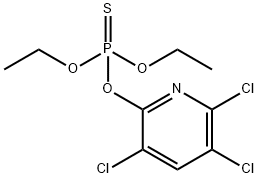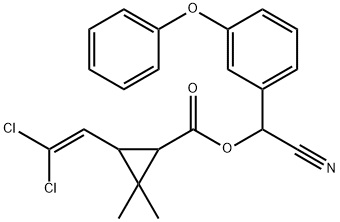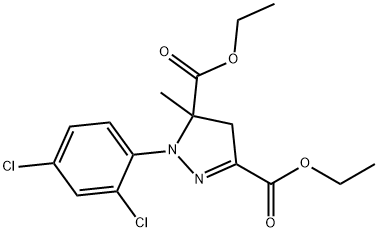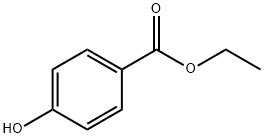Chlorpyrifos
Synonym(s):0,0-Diethyl-O-[3,5,6-trichloro-2-pyridyl]phosphorothioate;Chlorpyriphos
- CAS NO.:2921-88-2
- Empirical Formula: C9H11Cl3NO3PS
- Molecular Weight: 350.59
- MDL number: MFCD00041800
- EINECS: 220-864-4
- SAFETY DATA SHEET (SDS)
- Update Date: 2025-12-10 11:56:18

What is Chlorpyrifos?
Description
Chlorpyrifos is a chlorinated organophosphorus (OP) ester
manufactured as an insecticide, acaricide, and miticide. Like the
other OP insecticides, the most prominent toxicity of chlorpyrifos
is associated with binding and inhibition of the enzyme
acetylcholinesterase (AChE) in insects and mammals. Chlorpyrifos
requires metabolic activation to chlorpyrifos oxon to
yield anticholinesterase activity.
First sold in 1965, chlorpyrifos is used globally to control
agricultural and structural pests and mosquitos. In the 1990s,
chlorpyrifos ranked as one of the top selling pesticides in the
world, for the most part, replacing the persistent organochlorine
insecticides. Over the last decade, concerns regarding
toxicity to the developing nervous system have limited its use.
By 2001, residential uses and uses in schools and parks were
prohibited, and many agricultural uses were restricted and the
US Residential use limitations were also imposed in Canada,
Australia, and the European Union (EU). It continues to be
used in large quantities to control crop damage worldwide. In the developing countries, excessive agricultural application
and lack of protective devices result in hundreds of thousands
of deaths yearly.
Description
Chlorpyrifos is a thiophosphate insecticide and acaricide sold under such names as Lorsban and Dursban. Dow Chemical first marketed it in 1965 as a household pesticide. Because chlorpyrifos is associated with several health problems, in 2001 FDA severely restricted its use , but it is still widely used in some countries. More recently,?researchers found that it affects several regions of the brain.
Description
Chlorpyrifos is an organophosphate insecticide. It is lethal to A. melinus, G. ashmeadi, E. eremicus, and E. formosa adults (LC50s = 0.8, 6, 12, and 17 ng/ml, respectively). Chlorpyrifos induces mortality in O. insidiosus adults when applied to corn, sorghum, and alfalfa plants. It is toxic to mice (LD50 = 155 mg/kg). Postnatal day 11 to 14 exposure to chlorpyrifos (3 mg/kg) decreases nest building and defense behaviors in adult female mice. Formulations containing chlorpyrifos have been used in the control of insects in agriculture.
Chemical properties
Chlorpyrifos belongs to the class of insecticides known as organophosphates. Technical chlorpyrifos is an amber to white crystalline solid with a mild sulfur odor. It is insoluble in water, but soluble in benzene, acetone, chloroform, carbon disulfi de, diethyl ether, xylene, methylene chloride, and methanol. Formulations of chlorpyrifos include emulsifi able concentrate, dust, granular wettable powder, microcapsule, pellet, and sprays. Chlorpyrifos is widely used as an active ingredient in many commercial insecticides, such as Dursban and Lorsban, to control household pests, mosquitoes, and pests. Formulations of chlorpyrifos include emulsifi able concentrates, granules, wettable powders, dust, microcapsules, pellets, and sprays. The US EPA has classifi ed chlorpyrifos as a GUP
Physical properties
Chlorpyrifos is a white crystalline or irregularly flaked solid. Chlorpyrifos has a very faint mercaptan-type odor. Chlorpyrifos is not soluble in water. Chlorpyrifos can cause slight irritation to the eye and skin.
The Uses of Chlorpyrifos
Chlorpyrifos belongs to a class of insecticides known as organophosphates. Technical chlorpyrifos is amber to white crystalline solid with a mild sulphur odour. Formulations of chlorpyrifos include emulsifiable concentrate, dust, granular wettable powder, microcapsule, pellet, and sprays. Chlorpyrifos is widely used as an active ingredient in many commercial insecticides such as Dursban and Lorsban to control household pests, mosquitoes, and pests in animal houses. The U.S. EPA classified chlorpyrifos as GUP.
The Uses of Chlorpyrifos
Chlorpyrifos is an organophosphorus insecticide used to control insects on a wide variety of crops including fruits, vegetables, ornamentals and forestry
The Uses of Chlorpyrifos
Chlorpyrifos is used to control many types of insect pests in a wide range of crops and ornamentals. It is also used to control household pests, including termites.
What are the applications of Application
Chlorpyrifos is An organothiophosphate cholinesterase inhibitor that is used as an insecticide
Definition
ChEBI: An organic thiophosphate that is O,O-diethyl hydrogen phosphorothioate in which the hydrogen of the hydroxy group has been replaced by a 3,5,6-trichloropyridin-2-yl group.
Air & Water Reactions
Insoluble in water. Chlorpyrifos reacts with water and most reactive hydrogen compounds. The rate of hydrolysis in water increases with pH, with temperature and with the presence of copper and possibly other metals that can form chelates.
Reactivity Profile
Chlorpyrifos is sensitive to heat and is decomposed by moisture. Chlorpyrifos is hydrolyzed by strong alkalis. Chlorpyrifos is corrosive to copper and brass. Chlorpyrifos is also corrosive to copper alloys. Chlorpyrifos reacts with water and most reactive hydrogen compounds. The rate of hydrolysis in water increases with pH, with temperature and with the presence of copper and possibly other metals that can form chelates.
Health Hazard
Exposures to chlorpyrifos cause adverse health effects and poisoning. The symptoms include, but are not limited to, headache, dizziness, respiratory problems, muscular and joint pains, numbness, tingling sensations, incoordination, tremor, nausea, abdominal cramps, vomiting, sweating, blurred vision, respiratory depression, slow heart beat, nervousness, weakness, cramps, diarrhea, chest pain, pin-point pupils, tearing, salivation, clear nasal discharge and sputum, muscle twitching, and in severe poisonings convulsions, coma, and death. Exposures to chlorpyrifos cause adverse effects to the nervous system. The effects include phosphorylation of the active site, disturbance in the activity of the acetylcholinesterase (AChE) enzyme (inactivity). AChE enzyme is necessary to stop the transmission of the chemical neurotransmitter. In occupational workers, high concentrations of chlorpyrifos cause poisoning with symptoms of unconsciousness, convulsions and/or fatal injury. Persons with respiratory ailments and disturbed liver function are known to be at increased health risk. Also, repeated exposures to chlorpyrifos have been reported to cause disturbances in the process of brain development.
Health Hazard
Cholinesterase inhibitor; heavy exposurecan produce acute, delayed, and chroniceffect; exhibits low to moderate toxicity inexperimental animals when administered byoral and dermal routes; however, severity ofeffects varies with species; highly toxic tobirds; ingestion of 1.5–2 g would probablyresult in onset of cholinergic effects in adulthumans.
LD50 oral (rat): ~150 mg/kg
LD50 oral (rabbit): 1000 mg/kg
LD50 oral (wild bird): 5 mg/kg
LD50 oral (chicken): 25 mg/kg
LD50 skin (rat): ~200 mg/kg
LD50 skin (rabbit): 2000 mg/kg.
Fire Hazard
Combustible material: may burn but does not ignite readily. Containers may explode when heated. Runoff may pollute waterways. Substance may be transported in a molten form.
Flammability and Explosibility
Not classified
Agricultural Uses
Insecticide, Nematicide: A U.S. EPA restricted Use Pesticide (RUP). Chlorpyrifos is one of the most widely used insecticides in the U.S., both around the home and in agriculture. A broad-spectrum insecticide, originally used primarily to kill mosquitoes but no longer registered for that use. Chlorpyrifos is effective in controlling cutworms, corn rootworms, cockroaches, grubs, flea beetles, flies, termites, fire ants, and lice. It is used as an insecticide on grain, cotton, field, fruit, nut and vegetable crops, as well as on lawns and ornamental plants. It is also registered for direct use on sheep and turkeys, for horse site treatment, dog kennels, domestic dwellings, farm buildings, storage bins, and commercial establishments. Chlorpyrifos acts on pests primarily as a contact poison, with some action as a stomach poison. It is available as granules, wettable powder, dustable powder and emulsifiable concentrate. Top crop uses in California include cotton, alfalfa, almonds, and oranges.
Trade name
(Note: EPA Office of Pesticide Programs lists 2135 products, both active and past-registered) ALUDOR®; BAR 500 EC®; BRODAN®; CHLORBAN®; CHLORPIRIFOS 480 CE MILENIA®; CHOIR®; COROBAN®; CURIGNA®; CYREN®; DETMOL U. A. ®; DORSAN®; DORSAN®-C; DOWCO® 179; DURSBAN®; EF 121®; EMPIRE®; ERADEX®; GLOBAL CRAWLING INSECT BAIT®; KENSBAN®; LORSBAN®; MURPHY SUPER ROOT GUARD®; PAQEANT®; PILOT®; PYRINEX®); SCOUT®; SPANNIT®; STIPEND; TALON®; TAFABAN®; TERIAL®; TWINSPAN®
Safety Profile
Poison by ingestion, intraperitoneal, skin contact, and inhalation routes. Human systemic effects by ingestion: paresthesia, muscle weakness, coma. Experimental reproductive effects: developmental toxicity. Mutation data reported. When heated to decomposition it emits very toxic fumes of Cl-, NOx POx and SOx
Potential Exposure
A potential danger to those involved in the manufacture, formulation, and application of this insecticide.
First aid
If this chemical gets into the eyes, remove anycontact lenses at once and irrigate immediately for at least15 min, occasionally lifting upper and lower lids. Seek medical attention immediately. If this chemical contacts theskin, remove contaminated clothing and wash immediatelywith soap and water. Speed in removing material from skinis of extreme importance. Shampoo hair promptly if contaminated. Seek medical attention immediately. If thischemical has been inhaled, remove from exposure, beginrescue breathing (using universal precautions, includingresuscitation mask) if breathing has stopped and CPR ifheart action has stopped. Transfer promptly to a medicalfacility. When this chemical has been swallowed, get medical attention. Give large quantities of water and inducevomiting. Do not make an unconscious person vomit.Medical observation is recommended.
Carcinogenicity
Some recent studies have reported associations between chlorpyrifos exposure and increased risk for cancer for farm workers participating in the Agricultural Health Study. Specifically, increased risk for glioma and rectal cancer has been associated with chlorpyrifos exposure . Chlorpyrifos was also one pesticide associated with trends toward higher incidence of lung cancer through 2001 . For all cancers though, follow- up periods are short and exposures are based on recall so results may be unreliable.
Environmental Fate
Biological. From the first-order biotic and abiotic rate constants of chlorpyrifos in
estuarine water and sediment/water systems, the estimated biodegradation half-lives were
3.5–41 and 11.9–51.4 days, respectively (Walker et al., 1988)
Soil. Hydrolyzes in soil to 3,5,6-trichloro-2-pyridinol (Somasundaram et al., 1991).
The half-lives in a silt loam and clay loam were 12 and 4 weeks, respectively (Getzin,
1981). In another study, Getzin (1981a) reported the hydrolysis half-lives
Leoni et al. (1981) reported that the major degradation product of chlorpyrifos in soil
is 3,5,6-trichloro-2-pyridinol. The major factors affecting the rate of degradation include
chemical hydrolysis in moist soils, clay-catalyzed hydrolysis on dry soil s
Plant. The half-life of chlorpyrifos in Bermuda grasses was 2.9 days (Leuck et al.,
1975). The concentration and the formulation of application of chlorpyrifos will determine
the rate of evaporation from leaf surfaces. Reported foliar half-lives on tomato, orange and
cotton leaves were 15–139, 1.4–96 and 5.5–57 hours, respectively (Veierov et al., 1988).
Dislodgable residues of chlorpyrifos on cotton leaf 0, 24, 48, 72 and 96 hours after
application (1.1 kg/ha) were 3.64, 0.13, 0.071, 0.055 and 0.034 μg/m2, respectively (Buck
et al., 1980)
Surface Water. In an estuary, the half-life of chlorpyrifos was 24 days (Schimmel et
al., 1983).
Metabolic pathway
The metaboic fate of chlorpyrifos in soil, plants and animals is similar, with oxidative dealkylation or hydrolysis to diethyl phosphorothioate and 3,5,6-trichloro-2-pyridinol being the major route of detoxification. The latter metabolite is conjugated as the glycosides or glucuronides in plants and animals. De-ethylation is not a major route of detoxification in mammals. Activation by desulfuration to the active acetylcholinesterase inhibitor, chlorpyrifos oxon, occurs in both animals and plants but the compound is often not detected owing to its rapid rate of hydrolysis. Dechlorination of the chloropyridine ring also occurs in the environment, principally by photolysis.
Storage
Color Code—Blue: Health Hazard/Poison: Storein a secure poison location. Prior to working with chlorpyrifos you should be trained on its proper handling and storage. Chlorpyrifos must be stored to avoid contact withstrong bases, or acids, or acid fumes since violent reactionsoccur. Store in tightly closed containers in a cool, well-ventilated area away from sources of heat.
Shipping
UN2783 Organo phosphorus pesticides, solid, toxic, Hazard Class: 6.1; Labels: 6.1-Poisonous materials. UN3018 Organophosphorus pesticides, liquid, toxic, Hazard Class: 6.1; Labels: 6.1-Poisonous materials.
Degradation
Chlorpyrifos is hydrolysed in acid, neutral and alkaline solution (PM). In neutral solution (approximately pH 7 and 25 °C) the DT50 for decomposition was variously reported as between 29 and 72 days. DT50s in buffered solutions at pH 4.7,6.9 and 8.1 were reported as being 62.7,35.3 and 22.9 days respectively (Racke, 1993). Hydrolysis is much faster in alkaline solutions and the DT50 at pH 11 was reported as 0.5 day (Macalady and Wolfe, 1983). The mechanisms of hydrolysis and nature of the products are pH-dependent. As has been found with many organophosphates, O-dealkylation predominates at acid and neutral pH values and in alkaline solution the main mechanism is cleavage of the P-O-aryl bond. Macalady and Wolfe (1983) showed that in buffered aqueous polar solvent mixtures at pH 9.7 to 12.9 the only products were 3,5,6-trichloro- 2-pyridinol(2) and diethyl phosphorothioate (3). In near neutral solution (pH 7.68) the main products were desethylchlorpyrifos (4) and ethanol with lesser amounts of 2 and 3. The mechanism for base-catalysed hydrolysis is via SN2 hydroxide attack on phosphorus, whereas under acid and neutral conditions the nucleophile is water and the rate is pH-independent with a half-life of 72.1 days and 72.9 days being reported at pH 5 and 7 respectively. Chlorpyrifos oxon (10, Scheme 2) was much more easily hydrolysed (Kenaga, 1971). Pathways for the hydrolytic degradation of chlorpyrifos in acid and base solution are shown in Scheme 1.
Toxicity evaluation
Chlorpyrifos undergoes abiotic hydrolysis, photodegradation,
and biotic degradation in soil and water. Depending on
the soil type and climate, its soil persistence varies from 2 weeks
to over 1 year. Microbial degradation is indicated by the shorter
half-lives in natural soils than sterile soils. Chemical hydrolysis
produces O-ethyl-O-3,5,6-trichloro-2-pyridyl phosphorothioate
or 3,5,6-trichloro-2-pyridinol (TCP) and phosphorthioic acid
at alkaline conditions. Half-lives in river and well waters vary
from 4.8 to 38 days, with the rate of hydrolysis increasing
with temperature and alkalinity. The estimated Log Koc of
3.73 predicts strong adsorption to soil and resist leaching
to groundwater. Chlorpyrifos can persist indoors for several
months.
Oxidation of chlorpyrifos to its more toxic metabolite chlorpyrifos
oxon could occur through photolysis, aerobic metabolism,
and chlorination. Water chlorination is the major route
of chlorpyrifos oxon formation. It is subsequently rapidly hydrolyzed toTCP.TCP and its glucuronide conjugates have been
detected in fish tissues. The measured Kow of 4.8 indicates
a potential for bioaccumulation in aquatic and terrestrial food
chains.
Incompatibilities
Above 130°C this chemical may undergo violent exothermic decomposition. The substance decomposes on heating at approximately 160°C and on burning, producing toxic and corrosive fumes including hydrogen chloride, nitrogen oxides; phosphorous oxides, sulfur oxides. Reacts with strong acids; strong bases; causing hydrolysis. Attacks copper and brass. Contact with oxidizers may cause the release of phosphorous oxides. Contact with strong reducing agents, such as hydrides, may cause the formation of flammable and toxic phosphine gas.
Waste Disposal
This compound is 50% hydrolyzed in aqueous MeOH solution at pH 6 in 1930 days; and in 7.2 days at pH 9.96. Spray mixtures of <1% concentration are destroyed with an excess of 5.25% sodium hypochlorite in <30 minutes @ 100°C; and in 24 hours @ 30°C. Concentrated (61.5%) mixtures are essentially destroyed by treatment with 100:1 volumes of the above sodium hypochlorite solution and steam in 10 minutes. In accordance with 40CFR165, follow recommendations for the disposal of pesticides and pesticide containers. Must be disposed properly by following package label directions or by contacting your local or federal environmental control agency, or by contacting your regional EPA office.
Precautions
Occupational workers should be careful during handling and use of chlorpyrifos. The workplace should have adequate washing facilities at all times and close to the site of handling and use. Eating, drinking, and smoking should be prohibited during handling and before washing after handling. Containers should be kept away from foodstuffs, animal feed and their containers, and out of reach of children.
Properties of Chlorpyrifos
| Melting point: | 42-44°C |
| Boiling point: | 200°C |
| Density | 1.398 |
| vapor pressure | 5.03 x 10-5 mmHg at 25 °C (subcooled liquid vapor pressure calculated from GC retention time data,Hinckley et al., 1990) |
| Flash point: | 2 °C |
| storage temp. | APPROX 4°C
|
| solubility | (At 25 °): 6.5, 7.9, 6.3, and 0.45 kg/kg in acetone, benzene, chloroform, and methanol, respectively
(Worthing and Hance, 1991) |
| form | solid |
| pka | -5.28±0.10(Predicted) |
| color | White to off-white |
| Water Solubility | Insoluble. 0.00013 g/100 mL |
| Merck | 13,2208 |
| BRN | 1545756 |
| Henry's Law Constant | 8.19 at 5 °C, 20.7 at 15 °C, 22.7 at 20 °C, 35.5 at 25 °C, 146 at 35 °C:in 3% NaCl solution: 32.3
at 5 °C, 82.9 at 15 °C, 301 at 25 °C, 535 at 35 °C (gas stripping-GC, Cetin et al., 2006) |
| Exposure limits | OSHA PEL: TWA 0.2 mg/m3, STEL 0.6 mg/m3; ACGIH TLV: TWA
0.2 mg/m3, STEL 0.6 mg/m3 |
| Stability: | Stable. Incompatible with strong oxidizing agents. |
| CAS DataBase Reference | 2921-88-2(CAS DataBase Reference) |
| NIST Chemistry Reference | o,o-Diethyl-o-(3,5,6-trichloro-2-pyridyl)phosphorothioate(2921-88-2) |
| EPA Substance Registry System | Chlorpyrifos (2921-88-2) |
Safety information for Chlorpyrifos
| Signal word | Danger |
| Pictogram(s) |
 Skull and Crossbones Acute Toxicity GHS06  Environment GHS09 |
| GHS Hazard Statements |
H301:Acute toxicity,oral H410:Hazardous to the aquatic environment, long-term hazard |
| Precautionary Statement Codes |
P264:Wash hands thoroughly after handling. P264:Wash skin thouroughly after handling. P270:Do not eat, drink or smoke when using this product. P273:Avoid release to the environment. P391:Collect spillage. Hazardous to the aquatic environment P301+P310:IF SWALLOWED: Immediately call a POISON CENTER or doctor/physician. P405:Store locked up. |
Computed Descriptors for Chlorpyrifos
| InChIKey | SBPBAQFWLVIOKP-UHFFFAOYSA-N |
Chlorpyrifos manufacturer
New Products
Indole Methyl Resin tert-butyl 9-methoxy-3-azaspiro[5.5]undecane-3-carboxylate Boc-His(Boc)-OH 2-CTC Resin 4-Chloro-7-tosy1-7Hpyrrolo[2,3-d]pyrimidine 5,7-Dibromo-1H-indole 2,5-dichloro-N-hydroxy-4,6-dimethylpyridine-3-carboximidamide 2,2-Dimethoxy-7-azaspiro[3.5]nonane hydrochloride 4-chloromethyl-5-methyl-1,3-dioxol-2-one (DMDO-Cl) R-2-BENZYLOXY PROPIONIC ACID 1,1’-CARBONYLDIIMIDAZOLE 1,1’-CARBONYLDI (1,2-4 TRIAZOLE) N-METHYL INDAZOLE-3-CARBOXYLIC ACID 4-((2-hydroxyethyl)thio)benzoic acid 1-(TERT-BUTOXYCARBONYL)-2-PYRROLIDINONE Methyl 6-methylnicotinate 3-Pyridineacrylic acid tert-Butyl carbazate TETRAHYDRO-2H-PYRAN-3-OL 2-((4-morpholinophenylamino) (methylthio) methylene) malononitrile 3-(4-morpholinophenylamino)-5-amino-1H-pyrazole-4-carbonitrile 2,4-dihydroxybenzaldehyde 1,3-Diethyl-1,3-Diphenylurea Methyl 2-methylquinoline-6-carboxylateRelated products of tetrahydrofuran








You may like
-
 Liquid Chlorpyrifos 20 % EC Insecticide, 100 ml, 250 ml, 500 ml, 1 LitView Details
Liquid Chlorpyrifos 20 % EC Insecticide, 100 ml, 250 ml, 500 ml, 1 LitView Details
2921-88-2 -
 Whiteoff RTU Chlorpyriphos 2% Rtu, Packet, ChlorpyrifosView Details
Whiteoff RTU Chlorpyriphos 2% Rtu, Packet, ChlorpyrifosView Details
2921-88-2 -
 Liquid Chlorpyrifos 50 % E .C, 500 mlView Details
Liquid Chlorpyrifos 50 % E .C, 500 mlView Details
2921-88-2 -
 Liquid Insecticide Chlorpyriphos 20% EC ManiBan 20View Details
Liquid Insecticide Chlorpyriphos 20% EC ManiBan 20View Details
2921-88-2 -
 Sun Brand Insect Control Capalon TC 50 Chlorpyrifos 50% EC Insecticides, Packaging Type: BottleView Details
Sun Brand Insect Control Capalon TC 50 Chlorpyrifos 50% EC Insecticides, Packaging Type: BottleView Details
2921-88-2 -
 Liquid Chlorpyriphos 20% EC Insecticide, 1 LView Details
Liquid Chlorpyriphos 20% EC Insecticide, 1 LView Details
2921-88-2 -
 Liquid Chlorpyriphos 20% EC Insecticide, 1ltrView Details
Liquid Chlorpyriphos 20% EC Insecticide, 1ltrView Details
2921-88-2 -
 Granules Chlorpyrifos 10 Gr, 5 KgView Details
Granules Chlorpyrifos 10 Gr, 5 KgView Details
2921-88-2
